Crime and Punishment: Ideology Trumps Reason
Most Recent: Texas Conservatives Reject Harpers Plan
News Flash: October 28, Times Colonist (A2), Pot Laws Fuel Gang Wars. An Angus Reid poll shows very little public support for maintaining tough laws against marihuana.
Introduction
Too often Governments are driven by ideology rather than reason and common sense of which the recent introduction of the Omnibus Crime Bill (C-10) is another example. In an earlier decade, the Liberals walked a similar path with their Long Gun Registry5.
While “let’s get tough with crime” resonates well within the general population, governments 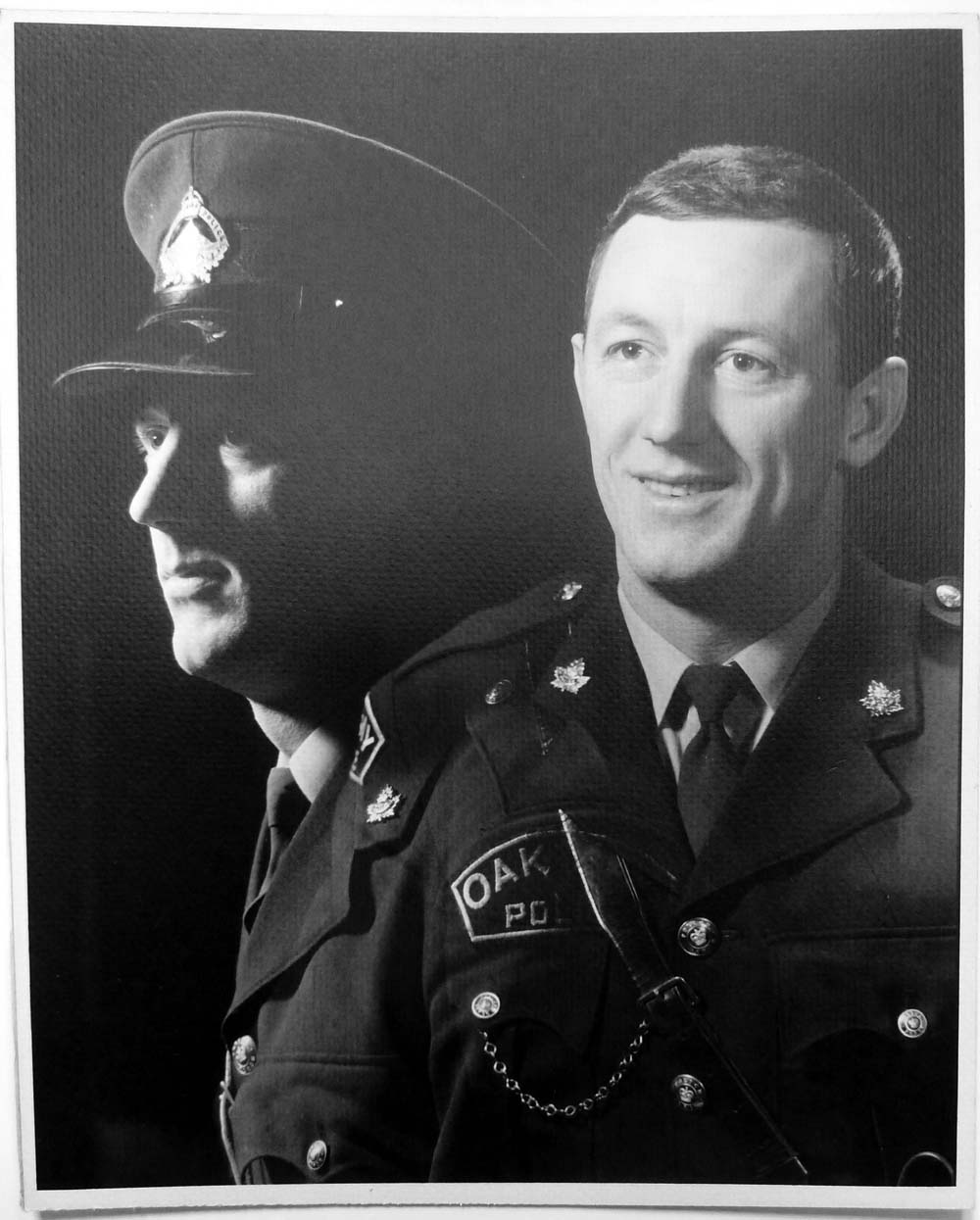 must seek to avoid painting all criminal transgressions with the same brush. Paedophiles, child pornographers, rapists, murders and other violent criminals clearly fall into a different category than do those who commit property crimes or are involved in the use or distribution of soft drugs.
must seek to avoid painting all criminal transgressions with the same brush. Paedophiles, child pornographers, rapists, murders and other violent criminals clearly fall into a different category than do those who commit property crimes or are involved in the use or distribution of soft drugs.
Photo (1966): The author spent thirty years working the front lines as a police officer as well as studying criminal justice and law reform issues both at University (BSc, 1974) and as a private interest. After retiring in 1994 with the rank of Detective-Sergeant, the author continues to study and write on crime and punishment issues.
For Canadians, we have only to look south of the border to see the impact of broad-spectrum “tough on crime” initiatives such as “three strikes and your out” and “mandatory minimums”, to see the results (Ref: Graph 4; Pie Chart 5). We are even being warned by many legislators and legal scholars in the United States against following in the footsteps of the USA. It is certainly not a path we want to follow, yet a portion of Bill C-10 charts just that course.
I encourage each of you to take a few minutes to read or scan this article and consider the arguments made for taking a more reasonable approach.
Harold McNeill
Victoria, BC
October 2011
1. Law and Order
All Canadian political parties, even those with the slimmest chance of becoming the governing party at the national or provincial level, play the ‘law and order’ card as a means to gain votes. A ‘Safe Streets and Communities’ or a ‘Tough on Crime’ strategy always plays well in a world explained in thirty-second news clips of random, isolated, violent, but infrequent criminal acts, many of which occur in other countries. It is made to appear these criminals are ruling the streets within every community.
Statistical trends, (local and worldwide), expert opinions, experience with crime suppression legislation in other jurisdictions and basic ‘reason’ have little impact when it comes to changing well-established beliefs about crime. For politically expedient reasons, governments likewise choose to ignore the evidence.
For example, crime in Canada, with few exceptions, has been in steep decline (also Charts 1, 2, and 3) for twenty years largely due to the changing demographics of our society – older people simply do not commit as many crimes. The governing Conservatives seem not to recognize this fact, nor do they seem to understand that our entire justice system from prosecution offices, to the courts and jails, is currently bursting at the seams. Without making any of the changes listed in Bill C-10, the current system requires a tremendous injection of funds just to maintain the stability.
That pressure, along with ongoing cutbacks in Provincial and Federal spending in an attempt to reduce deficits, has resulted in hundreds of accused, many charged with serious offences, have had their charges dropped for want of prosecutors, judges and courtrooms. In protest, dozens of prosecutors across the country (many in Quebec) have walked away from the system. Even at current levels of conviction and sentencing, finding room for new placements in Provincial and Federal institutions has reached a crisis point.
2. Why Violent Crime Initiatives May Fail
While Bill C-10, the Omni-Bus Bill currently before Parliament, suggests it represents a ‘get tough’ on ‘hard’ crime, the package could well have just the opposite effect because the vast majority of those affected by C-10 will be those committing non-violent and victimless (‘soft’) crimes.
It is well established the Criminal Justice system, from the courts to the prison system, are presently under considerable stress. As the system becomes further clogged with non-violent cases (e.g. property crimes, marihuana distribution and possession, ‘grow ops’, etc), the prosecution of more serious crimes (e.g. rape, murder, robbery, child molestation, paedophiles, organized crime, gangs, etc.) may be delayed. Considerable publicity has been given to dozens of cases involving extremely violent criminals are now walking the streets after having their cases thrown out due to extreme delay.
The sections of C-10 that will pose the greatest challenge are those related to ‘mandatory minimums’3 and, to a lesser extent, removal of conditional sentences (house arrest). Minister of Justice Rob Nicholsen, stuck in a position of having to justify the initiatives, often fumbles when asking about the legislation.2 Little wonder – in another decade, Mr. Nicholsen was vice chair of a parliamentary committee that came out strongly against ‘mandatory minimums’ the rationale being that it would unduly hamstring Judges dealing with complex variables in many criminal cases.
Who are the persons most affected in this new world order of crime and punishment? It will be  those convicted of non-violent, ‘victimless’ crimes such as cultivating pot (as few as six plants) and those involved in the distribution system. In some instances, the mandatory minimum penalties for pot offenders will exceed those applicable to child sex offenders. If this sounds unreasonable, take time to research the mandatory minimums legislation.
those convicted of non-violent, ‘victimless’ crimes such as cultivating pot (as few as six plants) and those involved in the distribution system. In some instances, the mandatory minimum penalties for pot offenders will exceed those applicable to child sex offenders. If this sounds unreasonable, take time to research the mandatory minimums legislation.
Photo: These pot plants, on the deck of a rural Salt Spring Island rental residence in British Columbia, were part of a larger ‘grow op’. Under the proposed legislation, just the plants on the deck could result in a year of imprisonment for each of the residents who appeared to otherwise be law-abiding, productive citizens. The details of this case will be published later in the Police Notebook Series. Photo by the author taken during a 1980s investigation.
3. That Ubiquitous Weed
Since the 1960s, marihuana has continued to permeate all socio-economic levels of our culture but, as with many laws, it is those at the lower levels who most often get caught up in the law enforcement web. Today, pot is a multibillion-dollar enterprise4 in Canada with British Columbia at the epicentre. With ever-increasing demand, particularly in the United States, there are now so many ‘grow ops’ throughout the Southern Interior and BC Coastal Islands, the RCMP and other police agencies have largely given up on large-scale enforcement as being a waste of scarce police resources (ref: CBC radio interviews with RCMP officers in the Kootenays, late September 2011).
Even with less emphasis being dedicated to marihuana enforcement across Canada, more than 18,000 individuals, largely small-time growers and distributors, are still convicted each year. In the future, a majority of those persons will be subject to mandatory minimum sentences that will require thousands of new prison cells and staff for which few contingency plans have been made or money allocated. Granted the Federal and Provincial Governments have budgeted considerable money for new prison space and personnel, but that is being done to relieve current over-crowding partially caused by other, recent, ‘law and order’ revisions(e.g. removal of the ‘two for one’ provisions, etc.).
4. The United States Experience
In both the short and long term, mandatory minimum sentences will not change behaviours any more than did prohibition in the United States stop people from purchasing and consuming alcohol. What it will do is create an influx of individuals into an already stressed court and prison system. As most of those convicted will be held in Provincial facilities, the costs will become the entire responsibility of the Provinces, the costs of which is estimated to be in the order of ten billion. When this finally dawns on politicians, particularly those in British Columbia, there is bound to be a backlash as us now evident south of the border.
Today, in the United States, we are beginning to see many highly placed Republicans (who make our Conservative leaders look like raving socialists) admitting the ‘get tough on crime’ initiatives that began in the Regan era and perpetuated by ongoing administration, have been
a failure. (Ref Charts 4 and 5). Even with extremely harsh penalties, demand for pot has grown exponentially. Many US States are now rescinding or relaxing the laws in an effort to salvage their justice systems. Dozens of other States will soon follow suit. To see Canada embarking upon a path the US began walking over two decades ago makes no sense what-so-ever.
By way of comparison, if we were to lock up as many people in Canada as they do in the United States, our prison population would move from its current level of roughly 45,000 to an extraordinary 210,000-245,000. ‘Scare’ tactics’, yes, perhaps, but that is the reality of using ‘prison’ as a primary means of bringing compliance to all criminal laws without regard to type, just as they have done in the United States over the past 30 years.
5. The Hidden Victims of “Tough on Crime” Legislation
To carry the costs of the new ‘tough on crime’ legislation, money will need to be diverted from other parts of the system and, as is often the case, programs for the mentally ill, disadvantaged and disabled are frequently the first targets. It has long been established these persons make up a disproportionate share of prison populations and slashing programs 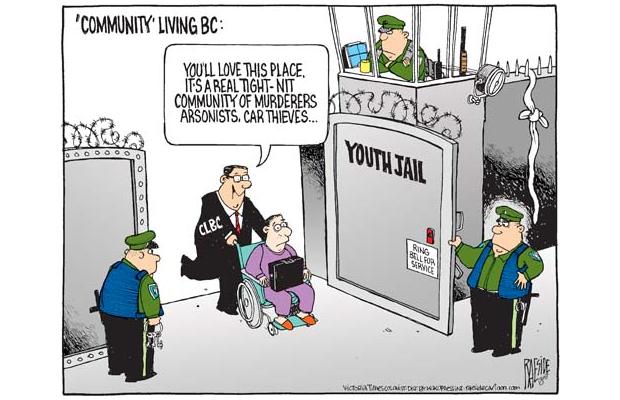 will invariably create new challenges that will put more pressure on the courts and prisons. It is a vicious cycle destined to spiral downward as has happened in the United States with their ongoing ‘war on drugs’, ‘war on crime’ ‘war on terror’ and ‘three strikes and your out’ strategies.
will invariably create new challenges that will put more pressure on the courts and prisons. It is a vicious cycle destined to spiral downward as has happened in the United States with their ongoing ‘war on drugs’, ‘war on crime’ ‘war on terror’ and ‘three strikes and your out’ strategies.
Cartoon: Adrian Raeside political cartoon in the Times Colonist on November 12, 2011.
The other groups seriously affected by overzealous imprisonment are the families of those incarcerated (usually men), who are left to fend for themselves. You might take a hard approach and say ‘tough luck’ that is the result of making bad decisions, but the reality is, many sent to prison would have otherwise been law-abiding individuals who held jobs and were supporting families (reference the grow op picture above taken on Salt Spring Island).
Even if the Conservatives come to admit the path is not sustainable, billions will have been wasted (as with the Long Guns Registry) and tens of thousands of lives affected as the Government attempts to reign in the crime and punishment tsunami they continue to unleash. When removed from power, as they certainly will during some future election, another party will be given the opportunity to reverse the direction but, unfortunately, will likely implement costly ideologies of their own.
Will there come a time when facts, reason and ‘common sense’ prevail over ideology? Probably not, as long as we allow ourselves to be seduced into believing our lives are endangered by murders, rapists, paedophiles and internet prowlers, drug traffickers, terrorists, organized gangs and others that, we have been confidently assured, are lurking just around the corner, waiting to pounce on the innocent and unsuspecting.
October 2011
Footnotes
1 Incarceration Rates: In the United States, in 2008, approximately one in every 31 adults (7.3 million) was behind bars, or being monitored (probation and parole). In 2008 the breakdown for adults under correctional control was as follows: one out of 18 men, one in 89 women, one in 11 African-Americans (9.2%), one in 27 Latinos (3.7%), and one in 45 whites (2.2%). Crime rates have declined by about 25 percent from 1988-2008.[13] 70% of prisoners in the United States are non-whites.[14] In recent decades the U.S. has experienced a surge in its prison population, quadrupling since 1980, partially as a result of mandatory sentencing that came about during the “war on drugs.” Violent crime and property crime have declined since the early 1990s.[15]
While the argument could be made that the dropping “crime rate” in the US was due to locking up more criminals, that argument would disregard the fact that crime has been dropping in every democratic country. The number sent to prison in all other countries is just a fraction of the number sent to prison in the USA, therefore, one might infer that other factors are at work.
2 “We do not use statistics as an excuse not to get tough on criminals.” That was federal Justice Minister Rob Nicholson’s astonishing response to Statistics Canada’s finding in July that crime rates in Canada now stand at the same level they did in 1973. Another point being periodically made by the Justice Minister is that crime is ‘under-reported’. While that is true, that under-reported crime is generally of the non-violent type (car prowling, break and enter, etc). In the period of 1960 – 1990, during my time in service, police statistical collection methods were not nearly as refined as they are today meaning the amount of unreported crime back then was much larger than now. This suggests the drop in crime over the past 20 years is even greater than that reported.
3 Estimates vary widely, but, on average, 20,000 metric tons of marihuana are consumed in the United States each year. Of that, 10,000 metric tons are imported with less than 10% of the total being intercepted by various police agencies. This is likely about the same as the seizure rate for alcohol during prohibition. About 60% of the marihuana produced in Canada is exported to the US with the lion’s share coming from British Columbia’s 15,000 to 20,000 grow ops. While many are small-time operations for personal use only, there hundreds of consolidated operations. Police seizures in Canada run at about the same rate as that in the US, perhaps a little less as our local, provincial and national police forces have greatly scaled back enforcement in recent years.
4 For a good roundtable discussion including US Justice Department Officials on the subject of ‘Mandatory Minimums’ proposed for Canada, go to CBC Radio, The House
5 In the mid-1990s, the Liberal Government, after a few tragic events including the senseless killings at École Polytechnique (1989) and Concordia (1992), began an all-out push for mandatory long gun registration. Applauded by many citizens and police organizations, it was little more than an ideological platform designed to project an image of strength for law and order.
Once the path was charted and the idea accepted by the public, particularly those in urban areas, it was tabled in the Commons in 1995, implemented in 2001 and became mandatory in 2003. From the beginning, costs spiralled from millions to billions and not a shred of evidence was ever produced to show it made for ‘safer streets and communities.’ One good thing that could be said about the legislation was that it focused on prevention as opposed to detention, a strategy Governments seldom pursue.
Always staunch law and order populists, the Conservatives were unalterably opposed to the legislation as were their rank and file members, mainly those in rural and western constituencies. In order to appease the grassroots, the Conservatives vowed to remove the registry as soon as they gained power. Now having a majority, the registry will soon become a historical footnote. After billions were spent on the registry, the streets and communities across Canada will be just as safe as they were before the legislation became law.
I. Canadian Crime Rates
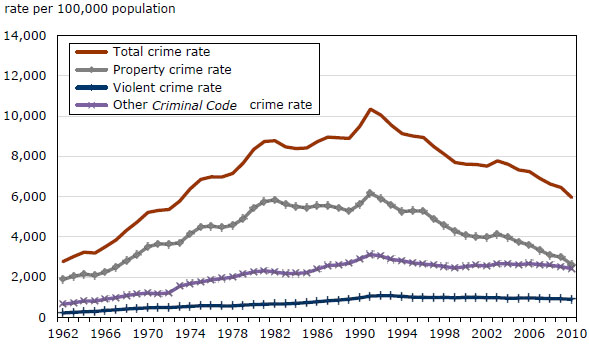
Overall, crime in Canada has been dropping since the early 1990s, a fact known by every police agency and reported by every media outlet. A challenge that remains – some types of violent crime continue to rise (murder is not one) so combined statistics can be a bit misleading. Because non-violent crime (property, marihuana and other victimless offences) is dropping at a significant rate, one wonders why Bill C-10 focuses far more heavily on those soft crimes than on violent crime.
2. Homicide Rates in Canada
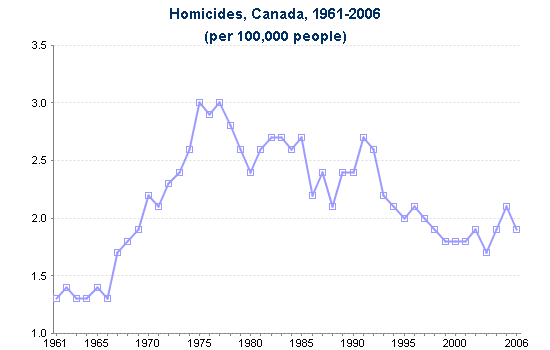
The homicide rate (number murders per 100,000) in Canada has been falling for decades and are now at the lowest rates since the late 1960s. This does not mean other aspects of violent crime are not rising. The challenge, Gangland killings (as with the recent killing of a gang leader outside a Kelowna casino) always gains major news coverage across the country. It is this coverage, and the heated rhetoric that follows, which makes it seem that murder is out of control. While every killing, gangland or otherwise, is cause for concern, we should not be lead to believe that these crimes are increasing in Canada. Take a look at the following graphic. While this is a narrow snapshot, it generally reflects the situation in the listed countries.
3. Homicides World Wide
While even one murder is one too many, Canada’s legislative and policing strategies over the past few decades, as well as an ageing population, is apparently paying dividends. In the United States, on the other hand, after implementing the most draconian measures to combat crime and drug use, have remained singularly ineffective. If we and our government think that by locking up more non-violent offenders, violent crime will be reduced, they (and we) will be wrong. In fact, it is just as likely to have the opposite effect.
4. Effects of Mandatory Minimum Sentences1 in the USA
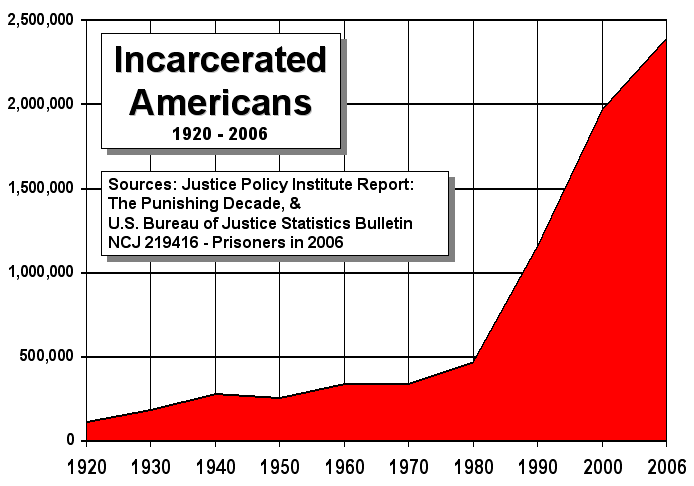
After viewing the two US Justice Department Graphs (above and below), it escapes me how senior bureaucrats and politicians in Ottawa, could not help but wonder if widespread use of “mandatory minimums”is the route we should follow in Canada. Whereas the percentage of inmates in Canada serving time for drug-related offences stands around 22%, the number in the US is 52% and rising. Imagine the effects on our society if we were to Americanize our justice and prison system!
5. Percentage Incarcerations Rates by Crime Type
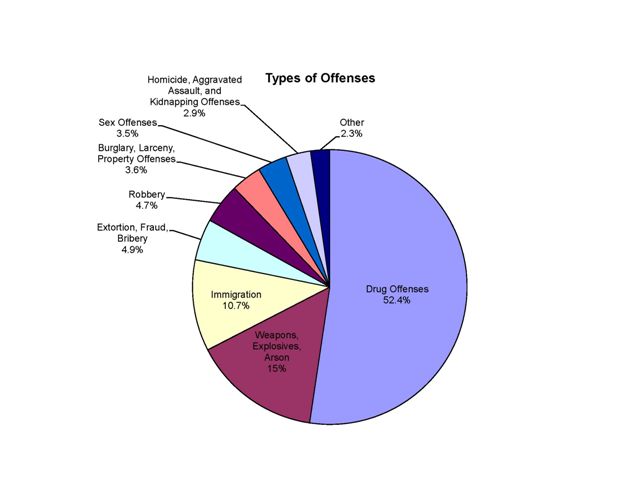
In 2006 the United States had the highest incarceration rate in the world at 573 per 100,000 (in 2010 it stood at over 700 and was still climbing) with lock them up and throw away key Russia, running a close second. The U.K (#99), Australia (#104), Canada (#123) and other Commonwealth Countries are in the range of 120 – 160 per 100,000. Your comments on the analysis outlined in this blog post
would be most appreciated.
September 28, 2011. National Post Article:
It is exceedingly difficult to find articles and commentary in support of the omnibus criminal-justice bill, however, one appeared in the National Post, September 28, 2011 (page A13). Written by Benjamin Perrin, a law professor at UBC and senior fellow at the MacDonald-Laurier Institute, he does about the only thing one could do to justify the full bill – he plays to the parts that have high public support.
In the article he highlights sections related to violent or morally repugnant crimes, items such as making and distributing child pornography, sexual assault of a child (various sub-sections), predatory paedophiles, date rape drug offences, etc. and uses those sections to indicate the entire bill has widespread support.
Mr. Perrin well knows that few, if any, would be opposed to the changes he highlights and most would support heavy penalties against those convicted of such offences, yet those offences are relatively infrequent occurrences within Canada and it is not those sections against which there has been an outpouring of public concern. Mr. Perrin has carefully avoided making any mention of the sections which will have the greatest overall impact and which will tend to swell our prison populations.
It is disingenuous of Professor Perrin, a supposedly intelligent man holding a full professorship at a respected University, to use his title and position to mislead the general public about the overall impact of the bill.
I would hazard to guess the Conservatives will, as they enter the debate, attempt to paint any who oppose the bill as ‘soft on crime’ and willing to let child abusers, porn distributors and others who commit horrendous crimes, walk free.
hdmc
7. Liberals and the Big Guns – A History Lesson
In the mid-1990s, the Liberal Government, after a few tragic events including the senseless killings at École Polytechnique (1989) and Concordia (1992), began an all-out push for mandatory long gun registration. Applauded by many citizens and police organizations, it was little more than an ideological platform designed to project an image of strength for law and order.
Once the path was charted and the idea accepted by the public, particularly those in urban areas, it was tabled in the Commons in 1995, implemented in 2001 and became mandatory in 2003. From the beginning, costs spiralled from millions to billions and not a shred of evidence was ever produced to show it made for ‘safer streets and communities.’ One good thing that could be said about the legislation was that it focused on prevention as opposed to detention, a strategy Governments seldom pursue.
Always staunch law and order populists, the Conservatives were unalterably opposed to the legislation as were their rank and file members, mainly those in rural and western constituencies. In order to appease the grassroots, the Conservatives vowed to remove the registry as soon as they gained power. Now having a majority, the registry will soon become a historical footnote. After billions were spent on the registry, the streets and communities across Canada will be just as safe as they were before the legislation became law.
hdmc
February 25, 2016 (1190)
(1827)
Trackback from your site.

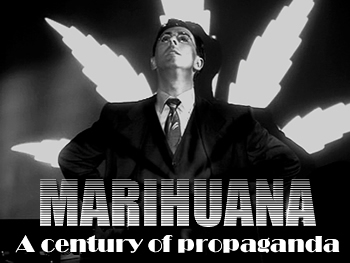
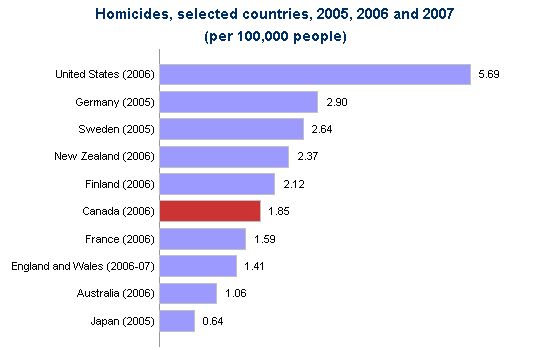
Comments (1)